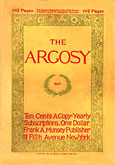Pulp magazines
Pulp magazines, or pulps, were inexpensive fiction magazines printed on paper made of wood pulp and sold to a mass market from the 1890s through the 1950s. A typical pulp magazine measured about 6 by 9 inches and totaled just over 120 pages, and sold for between 10 and 25 cents.
Background
 An issue of Argosy The Argosy from the 1890s.
An issue of Argosy The Argosy from the 1890s.MunseyFrankA Munsey’s Argosy Argosy was a natural evolution of the dime novel, a tabloid-size story papers full of melodramatic and inspirational fiction.
Other publishers followed MunseyFrankA Munsey’s lead, and within 20 years, numerous publishers, such as StreetandSmith Street and Smith were selling pulp magazines.
A typical pulp magazine
As the name implies, pulp magazines were inexpensive, popular magazines printed on paper made from the cheapest pulpwood. Publishers weren’t very concerned with the durability of the magazines, only that they were able to crank the magazines off the presses and get them into the hands of readers as cheaply and as often as possible.A typical pulp would include several short stories and serialized novels. With the advent of the HeroPulpGenre single-character pulps in the 1930s, the magazines began to include a complete lead novel in each issue.
Pulp magazines were usually around 6 by 9 inches in dimension, though BedsheetSize bedsheet varieties were around 8-1/2 by 11 inches, and DigestSize digest-size pulps were about 5-1/2 by 8-1/4 inches.
They contained three general classes of fiction: the short story; the novelette; and the booklength novel. Short stories were the most common and generally ranged under 15,000 words. Novelettes, literally “little novels,” ran from 15,000 to 40,000 words. Booklengths, generally 50,000 words or more, could run complete in some pulps. Many earlier pulps often ran booklengths in serial form in three or four consecutive numbers.
Pulps and slicks
The pulps were easily recognizable when compared to “slick” magazines, such the Saturday Evening Post or Time magazine, which were printed on slick, higher-quality paper. The pulps also typically had rough, untrimmed edges.But the difference between the pulps and other magazines didn’t end with appearance; it extended to the quality of content. Escapism was the pulps’ main goal, and they used any method they could to achieve that goal. Colorful, outlandish and sometimes risque covers beckoned newsstand perusers to escape into the magazine. And the stories inside were equally as colorful, outlandish and sometimes risque.
Pushing Depression-era woes out of their minds for a short while, readers were able to escape into realms of science fiction, horror, fantasy, crime and mystery, sports, westerns, romance and adventure through the pulps.
End of the pulps
The pulps reached their zenith in the 1930s, with more than 1,000 different pulp titles published during that period. Paper shortages during World War II spelled the beginning of the end for the magazines. By 1949, StreetandSmith Street and Smith had folded its pulp magazine because of declining circulation.Changing tastes after the war and competition from radio, television and inexpensive paperback books took their toll on the popular fiction magazines. By the end of the 1950s, pulps, for the most part, were history.
A few magazines lingered as DigestSize digests, such as AstoundingStories Astounding (later renamed AstoundingStories Analog), or evolved into MensMagazines men’s magazines, such as Argosy Argosy.
Writers for the pulps
Among the more famous authors who got their start during the half-century of the pulps were: BurroughsEdgarRice Edgar Rice Burroughs, LovecraftHP H.P. Lovecraft, AsimovIsaac Isaac Asimov, HammettDashiell Dashiell Hammett, LAmourLouis Louis L’Amour, BradburyRay Ray Bradbury, GardnerErleStanley Erle Stanley Gardner, MacDonaldJohnD John D. MacDonald, BrandMax Max Brand, HeinleinRobert Robert Heinlein, HowardRobertE Robert E. Howard and BlochRobert Robert Bloch.Many of the pulp authors wrote under pseudonyms or “HouseName house names,” which were fictitious author names assigned by the publisher to specific titles or characters. Also, by using pseudonyms, writers were able to publish more stories, which was important since they were paid by the number of words they wrote. The more stories they had published, the more money they could make.
Pulps vs. ‘pulp’ fiction
Pulp magazines are a specific category of magazine featuring light fiction that was fast-paced, sometimes lurid, sometimes sensational, but always written for entertainment.As PulpFictioneer fictioneer BedfordJonesH H. Bedford-Jones once said, “The fiction that is published in our popular magazines and in the standard novels commonly termed ‘trash,’ is turned out for the people at large. It is written for the average man in the street. It is democratic, carelessly so. It may be poor in art, in grammar and in technique — but it has to tell a story, and a good story, or it wwould not be published. Its aim is to entertain, not to point a moral.”
This description of light, lurid fiction as “pulp” has been carried over to the inexpensive paperback books that appeared in the 1940s and 1950s, and, even today, with movies such as Pulp Fiction. In truth, none of these fall into the “pulp” category as covered by PulpWiki or ThePulp.Net.
Pulp magazine category
The following 29 page(s) belong to PulpMagazines| Aces [Aces] |
| AvengerThe [AvengerThe] |
| CaptainFuture [Captain Future] |
| CaptainHazzard [Capt. Hazzard] |
| DetectiveStoryMagazine [DetectiveStoryMagazine] |
| DimeDetective [DimeDetective] |
| DimeMystery [DimeMystery] |
| DocSavage [DocSavage] |
| DustyAyres [DustyAyres] |
| FantasyGenre [FantasyGenre] |
| FaustFrederick [FaustFrederick] |
| FireFighters [Fire Fighters] |
| G8andHisBattleAces [G-8 and His Battle Aces] |
| GibsonWalter [GibsonWalter] |
| MerrittA [A. Merritt] |
| NewPulp [New Pulp] |
| Operator5 [Operator5] |
| PhantomDetectiveThe [The Phantom Detective] |
| PulpGenres [Pulp genres] |
| PulpMagazineRights [Pulp magazines rights] |
| PulpsterThe [The Pulpster] |
| PulpTerms [PulpTerms] |
| ShadowThe [ShadowThe] |
| SoldiersOfFortune [SoldiersOfFortune] |
| SpiderThe [SpiderThe] |
| StrangeStories [Strange Stories] |
| StreetandSmith [Street and Smith Publications Inc.] |
| Unknown [Unknown] |
| WesternStoryMagazine [WesternStoryMagazine] |
